Toyota RAV4 (XA40) 2013-2018 Service Manual: Evap system
Related dtcs
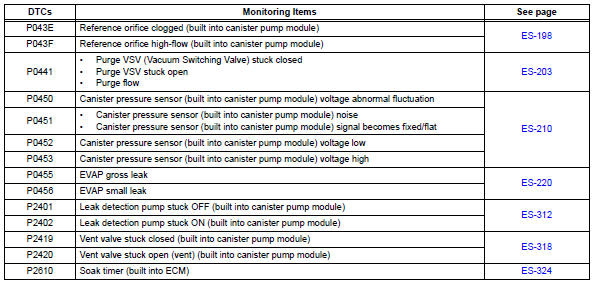
If any evap system dtcs are set, the malfunctioning area can be determined using the table below.
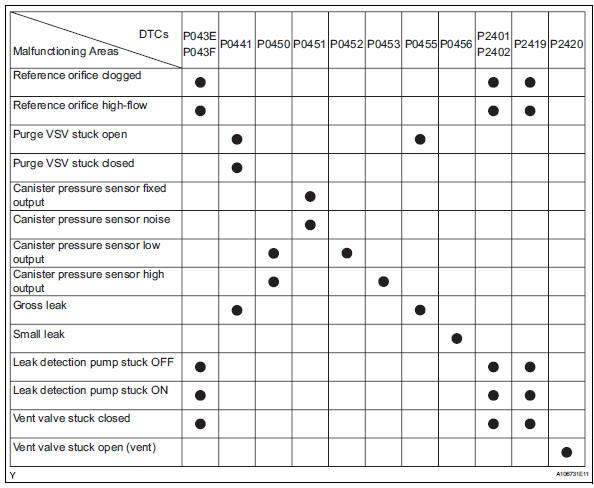
Notice:
If the reference pressure difference between the first and second checks is greater than the specification, all the dtcs relating to the reference pressure (p043e, p043f, p2401, p2402 and p2419) are stored.
Description
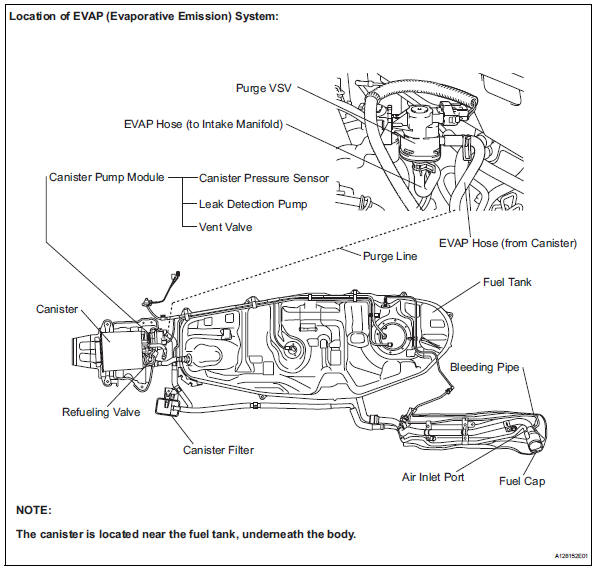
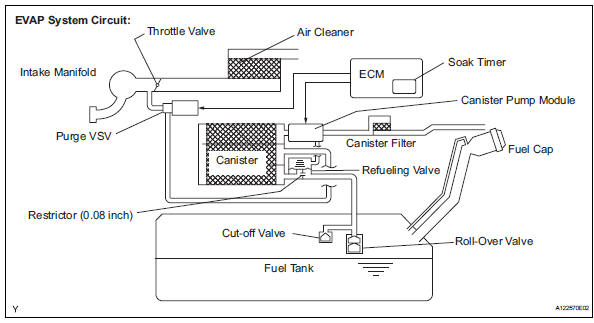
Notice:
In this vehicle's evap system, turning on the vent valve does not seal off the evap system. To check for leaks in the evap system, disconnect the air inlet vent hose and apply pressure from the atmospheric side of the canister.
While the engine is running, if a predetermined condition (closed-loop, etc.) Is met, the purge vsv is opened by the ecm and stored fuel vapors in the canister are purged into the intake manifold. The ecm changes the duty cycle ratio of the purge vsv to control purge flow volume.
The purge flow volume is also determined by the intake manifold pressure. Atmospheric pressure is allowed into the canister through the vent valve to ensure that the purge flow is maintained when the negative pressure (vacuum) is applied to the canister.
The following two monitors run to confirm the appropriate evap system operation.
- Key-off monitor
This monitor checks for evap (evaporative emission) system leaks and canister pump module malfunctions. The monitor starts 5 hours* after the ignition switch is turned off. At least 5 hours are required for the fuel to cool down to stabilize the evap pressure, thus making the evap system monitor more accurate.
The leak detection pump creates negative pressure (vacuum) in the evap system and the pressure is measured. Finally, the ecm monitors for leaks from the evap system, and malfunctions in both the canister pump module and purge vsv, based on the evap pressure.
Hint:
*: If the engine coolant temperature is not below 35°c (95°f) 5 hours after the ignition switch is turned off, the monitor check starts 2 hours later. If it is still not below 35°c (95°f) 7 hours after the ignition switch is turned off, the monitor check starts 2.5 Hours later.
- Purge flow monitor
The purge flow monitor consists of the two monitors. The 1st monitor is conducted every time and the 2nd monitor is activated if necessary.
- The 1st monitor
While the engine is running and the purge vsv (vacuum switching valve) is on (open), the ecm monitors the purge flow by measuring the evap pressure change. If negative pressure is not created, the ecm begins the 2nd monitor.
- The 2nd monitor
The vent valve is turned off (open) and the evap pressure is measured. If the variation in the pressure is less than 0.5 Kpa-g (3.75 Mmhg-g), the ecm interprets this as the purge vsv being stuck closed, and illuminates the mil and sets dtc p0441 (2 trip detection logic).
Atmospheric pressure check: in order to ensure reliable malfunction detection, the variation between the atmospheric pressures, before and after conduction of the purge flow monitor, is measured by the ecm.
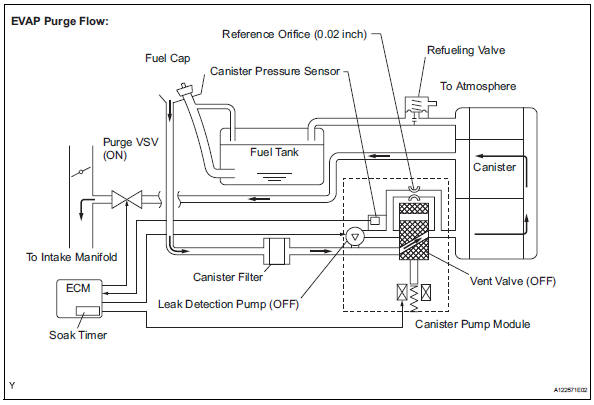
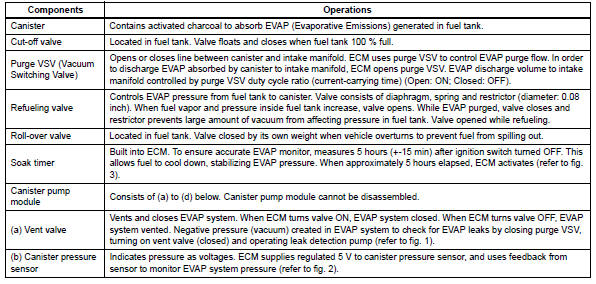

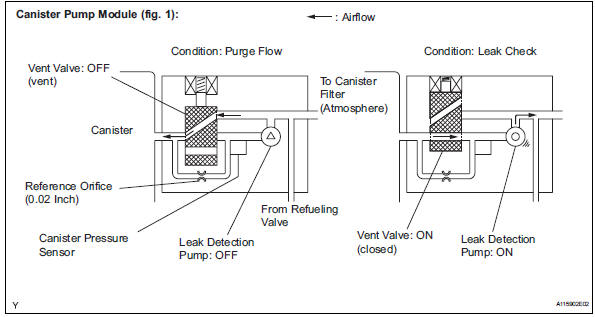
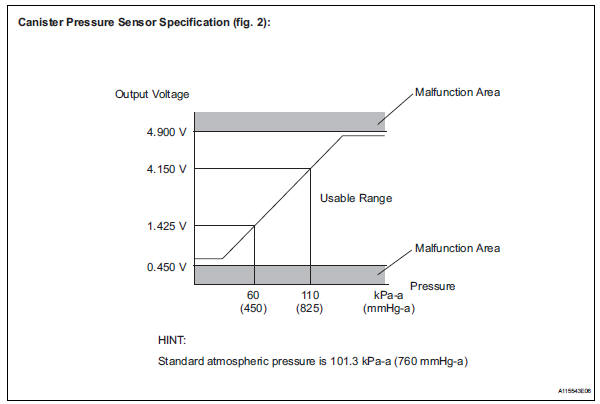
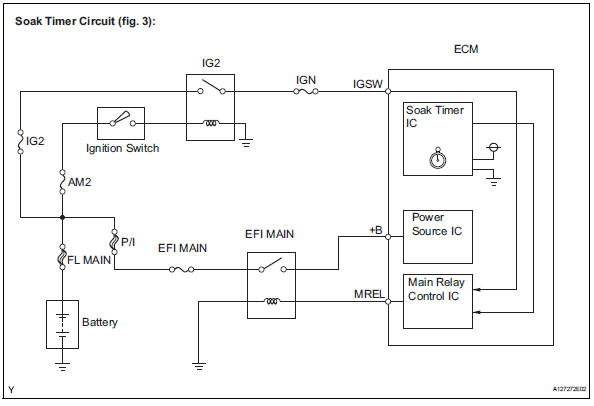
Wiring diagram
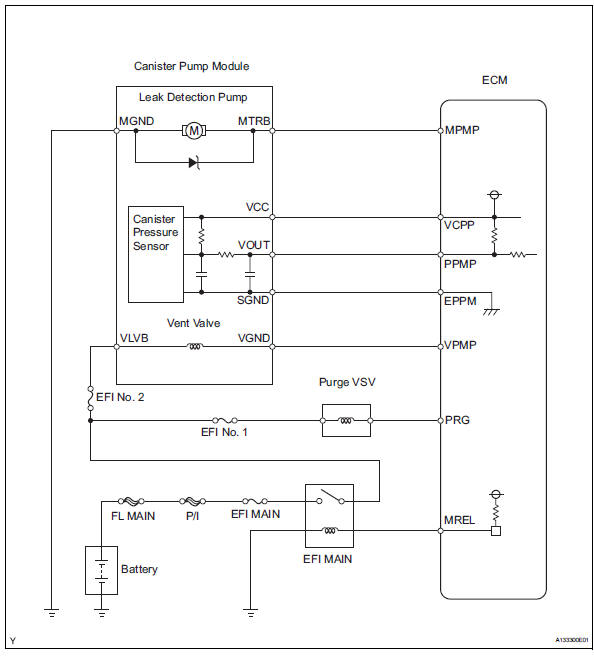
Inspection procedure
Notice:
The intelligent tester is required to conduct the following diagnostic troubleshooting procedure.
Hint:
- Using intelligent tester monitor results enables the evap (evaporative emission) system to be confirmed.
- Read freeze frame data using the intelligent tester. Freeze frame data records the engine condition when malfunctions are detected. When troubleshooting, freeze frame data can help determine if the vehicle was moving or stationary, if the engine was warmed up or not, if the air-fuel ratio was lean or rich, and other data from the time the malfunction occurred.
- Confirm dtc
- Turn the ignition switch off and wait for 10 seconds.
- Turn the ignition switch on.
- Turn the ignition switch off and wait for 10 seconds.
- Connect an intelligent tester to the dlc3.
- Turn the ignition switch on and turn the tester on.
- Confirm dtcs and freeze frame data.
If any evap system dtcs are set, the malfunctioning area can be determined using the table below.
Notice:
If the reference pressure difference between the first and second checks is greater than the specification, all the dtcs relating to the reference pressure (p043e, p043f, p2401, p2402 and p2419) are stored.
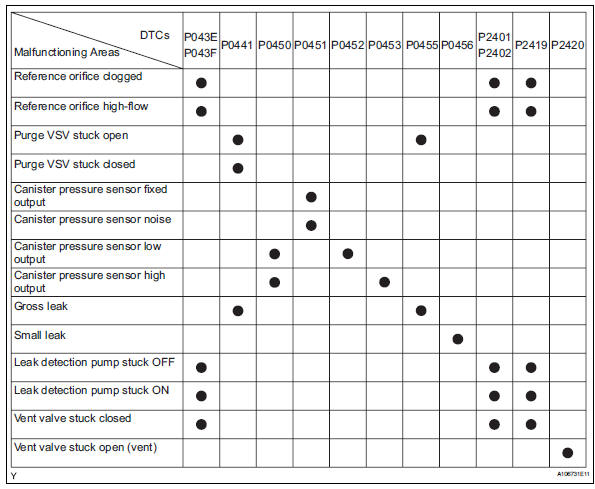

- Perform evap system check (auto operation)
Notice:
- The evap system check (auto operation) consists of 5 steps performed automatically by the intelligent tester. It takes a maximum of approximately 18 minutes.
- Do not perform the evap system check when the fuel tank is more than 90% full because the cut-off valve may be closed, making the fuel tank leak check unavailable.
- Do not run the engine during this operation.
- When the temperature of the fuel is 35°c (95°f) or more, a large amount of vapor forms and any check results become inaccurate. When performing the evap system check, keep the temperature below 35°c (95°f).
- Clear dtcs (see page es-35).
- On the tester, select the following menu items: diagnosis / enhanced obd ii / system check / evap sys check / auto operation.
- After the evap system check is completed, check for pending dtcs by selecting the following menu items: diagnosis / enhanced obd ii / dtc info / pending codes.
Hint:
If no pending dtcs are displayed, perform the monitor confirmation (see "diagnostic help" menu). After this confirmation, check for pending dtcs.
If no dtcs are displayed, the evap system is normal.

- Perform evap system check (manual operation)
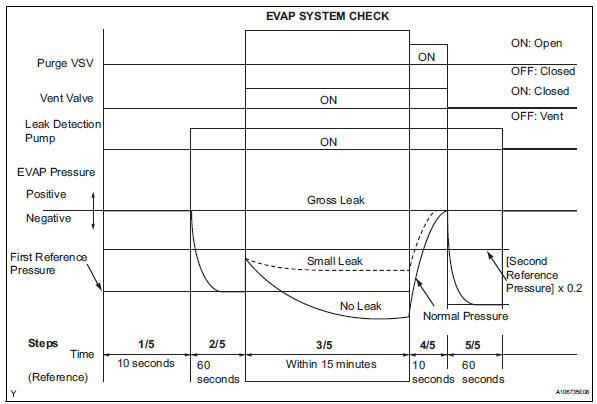
Notice:
- In the evap system check (manual operation), perform the series of 5 evap system check steps manually using the intelligent tester.
- Do not perform the evap system check when the fuel tank is more than 90% full because the cut-off valve may be closed, making the fuel tank leak check unavailable.
- Do not run the engine during this operation.
- When the temperature of the fuel is 35°c (95°f) or more, a large amount of vapor forms and any check results become inaccurate. When performing the evap system check, keep the temperature below 35°c (95°f).
- Clear dtcs (see page es-35).
- Select the following menu items: diagnosis / enhanced obd ii / system check / evap sys check / manual operation.

- Perform evap system check (step 1/5)
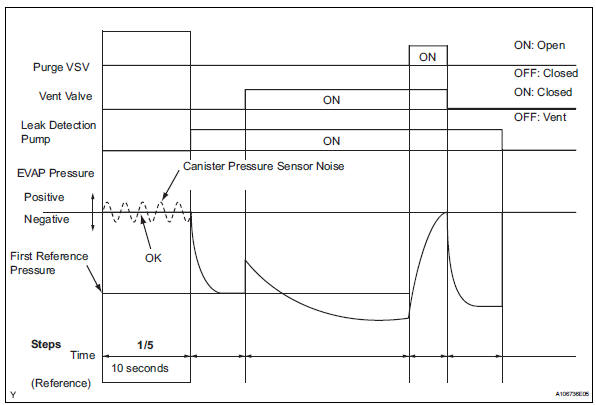
- Check the evap pressure in step 1/5.

*: These dtcs are already present in the ecm when the vehicle arrives and are confirmed in the "confirm dtc" procedures above.


- Perform evap system check (step 1/5 to 2/5)
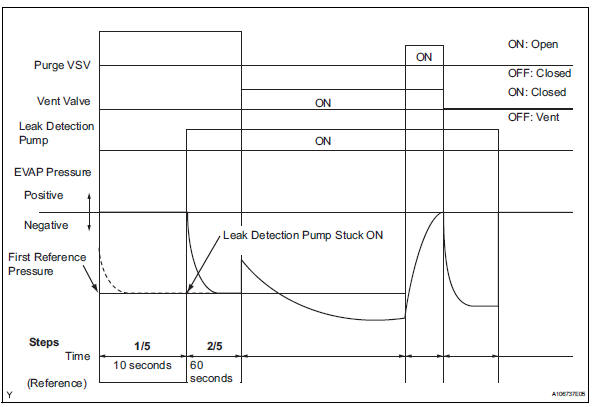
- Check the evap pressure in steps 1/5 and 2/5.

*: These dtcs are already present in the ecm when the vehicle arrives and are confirmed in the "confirm dtc" procedures above.
Hint:
The first reference pressure is the value determined in step 2/5.


- Perform evap system check (step 2/5)
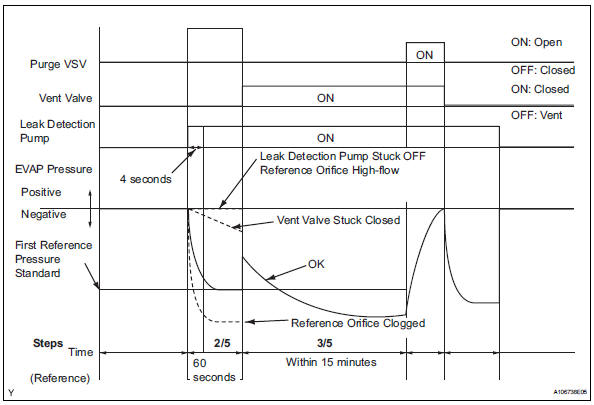
Hint:
Make a note of the pressures checked in steps (a) and (b) below.
- Check the evap pressure 4 seconds after the leak detection pump is activated*.
*: The leak detection pump begins to operate as step 1/5 finishes and step 2/5 starts.
- Check the evap pressure again when it has stabilized.
This pressure is the reference pressure.

*: These dtcs are already present in the ecm when the vehicle arrives and are confirmed in the "confirm dtc" procedures above.

- Perform evap system check (step 2/5 to 3/5)
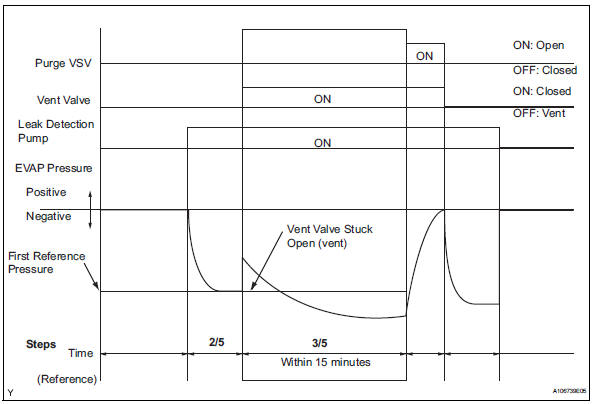
- Check the evap pressure increase in step 3/5.

*: These dtcs are already present in the ecm when the vehicle arrives and are confirmed in the "confirm dtc" procedures above.



- Perform evap system check (step 3/5)
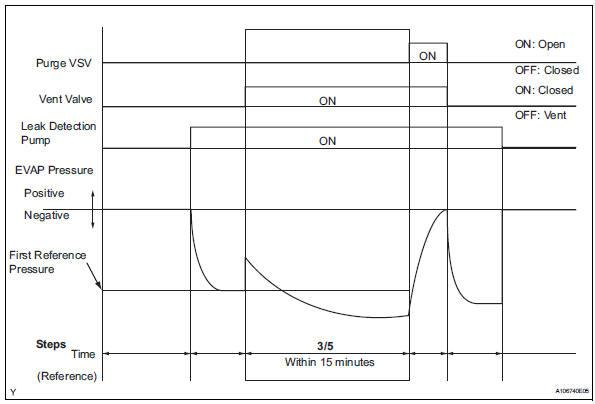
- Wait until the evap pressure change is less than 0.1 Kpa-g (0.75 Mmhg-g) for 30 seconds.
- Measure the evap pressure and record it.
Hint:
A few minutes are required for the evap pressure to become saturated. When there is little fuel in the fuel tank, it takes up to 15 minutes.

- Perform evap system check (step 4/5)
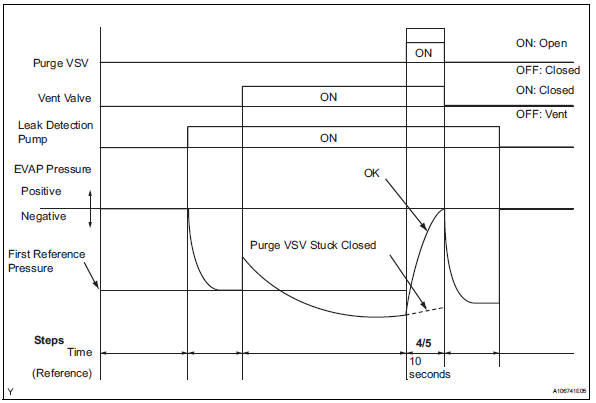
- Check the evap pressure in step 4/5.

*: These dtcs are already present in the ecm when the vehicle arrives and are confirmed in the "confirm dtc" procedures above.


- Perform evap system check (step 5/5)
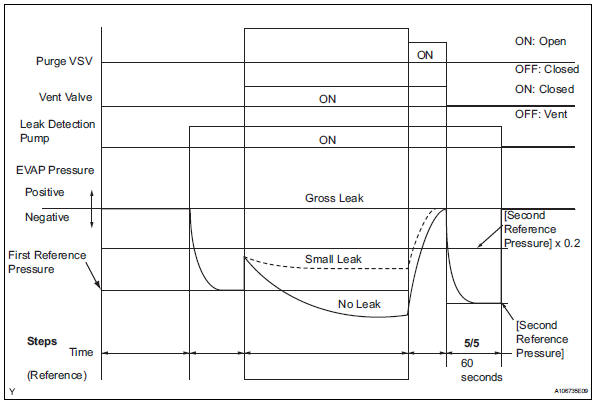
- Check the evap pressure in step 5/5.
- Compare the evap pressure in step 3/5 and the second reference pressure (step 5/5).

*: These dtcs are already present in the ecm when the vehicle arrives and are confirmed in the "confirm dtc" procedures above.

- Perform evap system check (step 3/5)
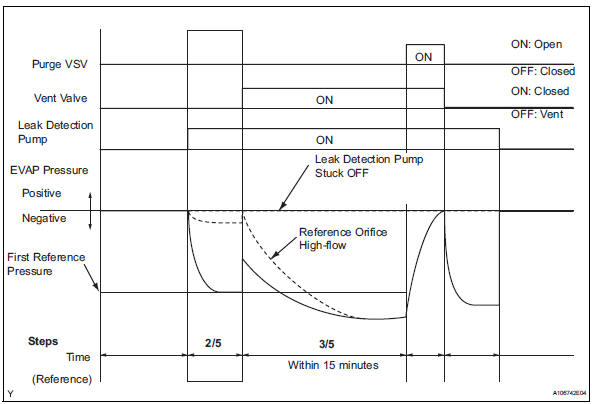
- Check the evap pressure in step 3/5.

*: These dtcs are already present in the ecm when the vehicle arrives and are confirmed in the "confirm dtc" procedures above.
Hint:
The first reference pressure is the value determined in step 2/5.

- Perform active test using intelligent tester (purge vsv)
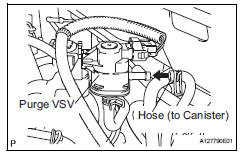
- On the intelligent tester, select the following menu items: diagnosis / enhanced obd ii / active test / evap vsv (alone).
- Disconnect the hose (connected to the canister) from the purge vsv.
- Start the engine.
- Using the tester, turn off the purge vsv (evap vsv: off).
- Use your finger to confirm that the purge vsv has no suction.
- Using the tester, turn on the purge vsv (evap vsv: on).
- Use your finger to confirm that the purge vsv has suction.

- Reconnect the hose.


- Check fuel cap assembly
- Check that the fuel cap is correctly installed and confirm the fuel cap meets oem specifications.
- Tighten the fuel cap until a few click sounds are heard.
Hint:
If an evap tester is available, check the fuel cap using the tester.
- Remove the fuel cap and install it onto a fuel cap adapter.
- Connect an evap tester pump hose to the adapter, and pressurize the cap to 3.2 To 3.7 Kpa (24 to 28 mmhg) using an evap tester pump.
- Seal the adapter and wait for 2 minutes.
- Check the pressure. If the pressure is 2 kpa (15 mmhg) or more, the fuel cap is normal.


- Reinstall the fuel cap.

- Inspect duty vacuum switching valve (purge vsv)
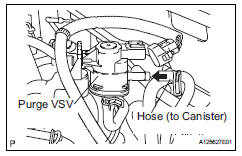
- Turn the ignition switch off.
- Disconnect the b2 purge vsv connector.
- Disconnect the hose (connected to the canister) from the purge vsv.
- Start the engine.
- Use your finger to confirm that the purge vsv has no suction.

- Reconnect the purge vsv connector.
- Reconnect the hose.

- Check evap hose (purge vsv - intake manifold)
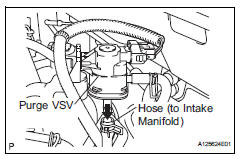
- Disconnect the hose (connected to the intake manifold) from the purge vsv.
- Start the engine.
- Use your finger to confirm that the hose has suction.

- Reconnect the hose.


- Inspect duty vacuum switching valve (purge vsv)
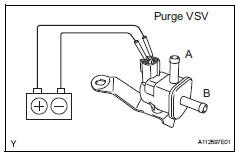
- Remove the purge vsv.
- Apply the battery voltage to the terminals of the purge vsv.
- Using an air gun, confirm that air flows from port a to port b.

- Install the purge vsv.


- Check harness and connector (power source of purge vsv)
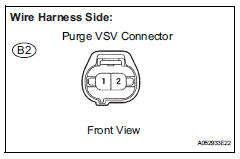
- Disconnect the b2 purge vsv connector.
- Turn the ignition switch on.
- Measure the voltage between terminal 2 of the purge vsv connector and the body ground.

- Reconnect the purge vsv connector.


- Check harness and connector (purge vsv - ecm)
- Disconnect the b30 ecm connector and the b2 purge vsv connector.
- Measure the resistance.
Standard resistance
- Reconnect the purge vsv connector.
- Reconnect the ecm connector.
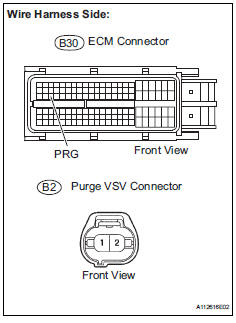

- Inspect canister pump module (power source for vent valve)
- Turn the ignition switch off.
- Disconnect the s3 canister pump module connector.
- Turn the ignition switch on.
- Measure the voltage between vlvb terminal of the canister pump module connector and the body ground.
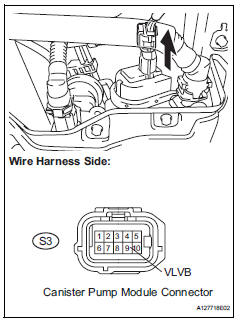
Result

- Reconnect the canister pump module connector.


- Inspect canister pump module (vent valve operation)
- Turn the ignition switch off.
- Disconnect the s3 canister pump module connector.
- Apply the battery voltage to vlvb and vgnd terminals of the canister pump module.
- Touch the canister pump module to confirm the vent valve operation.
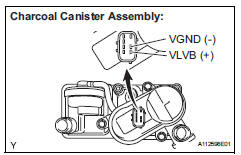

![]()
- Reconnect the canister connector.


- Check harness and connector (ecm - canister pump module)
- Disconnect the a9 ecm connector.
- Disconnect the s3 canister pump module connector.
- Measure the resistance between vpmp terminal of the ecm connector and vgnd terminal of the canister pump module connector.
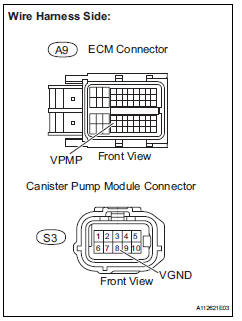

- Reconnect the ecm connector.
- Reconnect the canister pump module connector.

- Perform active test using intelligent tester (vacuum pump (alone))
- Turn the ignition switch off.
- Disconnect the s3 canister pump module connector.
- Turn the ignition switch on.
- On the intelligent tester, select the following menu items: diagnosis / enhanced obd ii / active test / vacuum pump.
- Measure the voltage between mtrb terminal 1 of the canister pump module connector and the body ground when the leak detection pump is turned on and off using the tester.
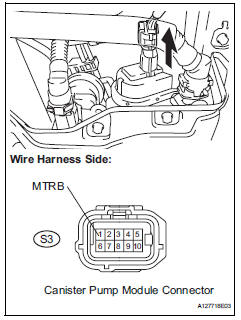

- Check harness and connector (canister pump module - body ground)
- Turn the ignition switch off.
- Disconnect the s3 canister pump module connector.
- Check the resistance between mgnd terminal of the canister pump module connector and the body ground.
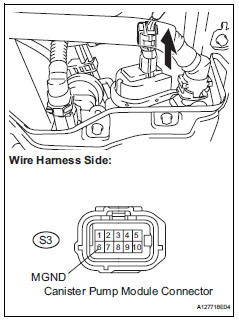

- Reconnect the canister pump module connector.

- Check harness and connector (ecm - canister pump module)
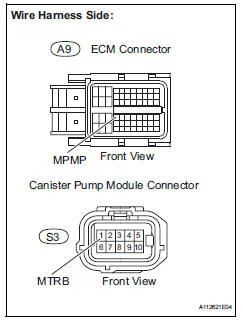
- Turn the ignition switch off.
- Disconnect the s3 canister pump module connector.
- Disconnect the a9 ecm connector.
- Measure the resistance between mpmp terminal of the ecm connector and mtrb terminal of the canister pump module connector.

- Reconnect the canister pump module connector.
- Reconnect the ecm connector.

- Inspect intake manifold (evap purge port)
- Stop the engine.
- Disconnect the evap hose from the intake manifold.
- Start the engine.
- Use your finger to confirm that the port of the intake manifold has suction.

- Reconnect the evap hose.

- Correctly reinstall or replace fuel cap
Hint:
- When reinstalling the fuel cap, tighten it until a few click sounds are heard.
- When replacing the fuel cap, use a fuel cap that meets oem specifications, and install it until a few click sounds are heard.

- Replace fuel cap
Hint:
When installing the fuel cap, tighten it until a few click sounds are heard.

- Locate evap leak part
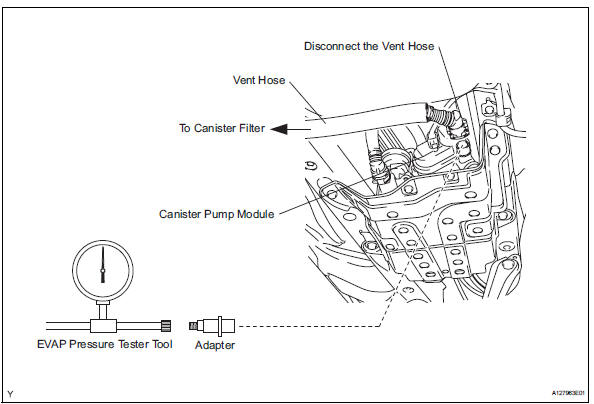
- Disconnect the vent hose.
- Connect the evap pressure tester tool to the canister pump module with the adapter.
- Pressurize the evap system to 3.2 To 3.7 Kpa (24 to 28 mmhg).
- Apply soapy water to the piping and connecting parts of the evap system.
- Look for areas where bubbles appear. This indicates the leak point.
- Repair or replace the leak point.
Hint:
Disconnect the hose between the canister and the fuel tank from the canister. Block the canister side and conduct an inspection. In this way, the fuel tank can be excluded as an area suspected of causing fuel leaks.

- Replace charcoal canister assembly
- Replace the canister assembly (see page ec-10).
Notice:
When replacing the canister, check the canister pump module interior and related pipes for water, fuel and other liquids. If liquids are present, check for disconnections and/or cracks in the following: 1) the pipe from the air inlet port to the canister pump module; 2) the canister filter; and 3) the fuel tank vent hose.
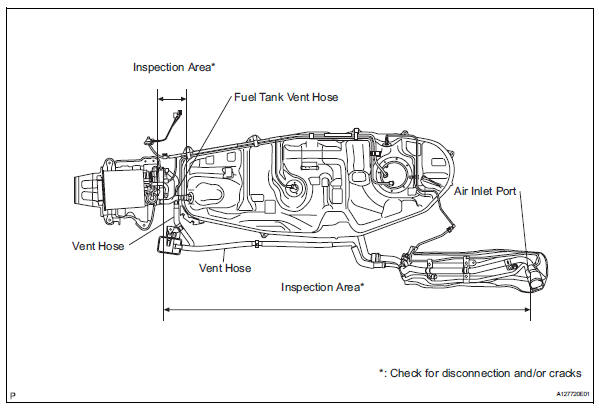

- Replace duty vacuum switching valve (purge vsv)
- Disconnect the connector and the hoses from the purge vsv.
- Remove the purge vsv.
- Install a new purge vsv.
- Reconnect the connector and hoses.
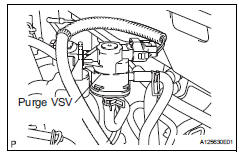

- Repair or replace harness or connector

- Replace evap hose (intake manifold - purge vsv)

- Inspect intake manifold (evap purge port)
- Check that the evap purge port of the intake manifold is not clogged. If necessary, replace the intake manifold.

- Replace ecm
- Replace the ecm (see page es-429).

- Repair or replace parts and components indicated by output dtcs
- Repair the malfunctioning areas indicated by the dtcs that had been confirmed when the vehicle was brought in.

- Perform evap system check (auto operation)
Notice:
- The evap system check (auto operation) consists of 5 steps performed automatically by the intelligent tester. It takes a maximum of approximately 18 minutes.
- Do not perform the evap system check when the fuel tank is more than 90% full because the cut-off valve may be closed, making the fuel tank leak check unavailable.
- Do not run the engine in this step.
- When the temperature of the fuel is 35°c (95°f) or more, a large amount of vapor forms and any check results become inaccurate. When performing an evap system check, keep the temperature below 35°c (95°f).
- Clear dtcs (see page es-35).
- On the intelligent tester, select the following menu items: diagnosis / enhanced obd ii / system check / evap sys check / auto operation.
- After the system check is completed, check for pending dtcs by selecting the following menu items: diagnosis / enhanced obd ii / dtc info / pending codes.
Hint:
If no pending dtcs are found, the repair has been successfully completed.

Completed
Confirmation driving pattern
Hint:
After a repair, check monitor status by performing the key-off monitor confirmation and purge flow monitor confirmation described below.
- Key-off monitor confirmation
- Preconditions
The monitor will not run unless:
- The vehicle has been driven for 10 minutes or more (in a city area or on a freeway)
- The fuel tank is less than 90 % full
- The altitude is less than 8,000 ft (2,400 m)
- The engine coolant temperature (ect) is between 4.4°C and 35°c (40°f and 95°f)
- The intake air temperature (iat) is between 4.4°C and 35°c (40°f and 95°f)
- The vehicle remains stationary (the vehicle speed is 0 km/h [0 mph])
- Monitor conditions
- Allow the engine to idle for at least 5 minutes.
- Turn the ignition switch off and wait for 6 hours (8 or 10.5 Hours).
Hint:
Do not start the engine until checking monitor status. If the engine is started, the steps described above must be repeated.
- Monitor status
- Connect the intelligent tester to the dlc3.
- Turn the ignition switch on and turn the tester on.
- Select the following menu items: diagnosis / enhanced obd ii / monitor status.
- Check the monitor status displayed on the tester.
Hint:
If incmp is displayed, the monitor is not complete. Make sure that the preconditions have been met, and perform the monitor conditions again.
- Purge flow monitor confirmation (p0441)
Hint:
Perform this monitor confirmation after the key-off monitor confirmation shows compl (complete).
- Preconditions
The monitor will not run unless:
- The vehicle has been driven for 10 minutes or more (in a city area or on a freeway)
- The ect is between 4.4°C and 35°c (40°f and 95°f)
- The iat is between 4.4°C and 35°c (40°f and 95°f)
- Monitor conditions
- Release the pressure from the fuel tank by removing and reinstalling the fuel cap.
- Warm the engine up until the ect reaches more than 75°c (167°f).
- Increase the engine speed to 3,000 rpm once.
- Allow the engine to idle and turn a/c on for 1 minute.
- Monitor status
- Turn the ignition switch off (if on or the engine is running).
- Connect the intelligent tester to the dlc3.
- Turn the ignition switch on and turn the tester on.
- Select the following menu items: diagnosis / enhanced obd ii / monitor status.
- Check the monitor status displayed on the tester.
Hint:
If incmp is displayed, the monitor is not complete. Make sure that the preconditions have been met, and perform the monitor conditions again.
Monitor result
Refer to checking monitor status (see page es-17).
 A/f sensor circuit slow response (bank 1 sensor 1)
A/f sensor circuit slow response (bank 1 sensor 1)
Hint:
Sensor 1 refers to the sensor mounted in front of the three-way catalytic
converter (twc) and located
near the engine assembly.
Description
Refer to dtc p2195 (see page es-292).
M ...
 Ecm power source circuit
Ecm power source circuit
Description
When the ignition switch is turned on, the battery voltage is applied to the
igsw of the ecm. The output
signal from the mrel terminal of the ecm causes a current to flow to the coil, ...
Other materials:
Closing the fuel tank cap
After refueling, turn the fuel tank
cap until you hear a click. Once
the cap is released, it will turn
slightly in the opposite direction.
Caution
When replacing the fuel tank cap
Do not use anything but a genuine toyota fuel tank cap designed for
your
vehicle. Doing so may cause a fire ...
Terminals of ecm
Check ecm
Measure the voltage of the ecm connector.
Hint:
Each ecm terminal's standard voltage is shown in
the table below.
In the table, first follow the information under
"condition". Look under "symbols (terminal no.)"
For the terminals to be inspected. ...
If the vehicle battery
is discharged
The following procedures may be used to start the engine if the
vehicle’s battery is discharged.
You can also call your toyota dealer or a qualified repair shop.
If you have a set of jumper (or booster) cables and a second vehicle
with a 12-volt battery, you can jump start your vehicle by fo ...
